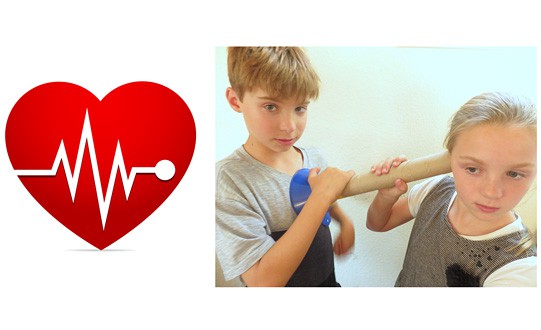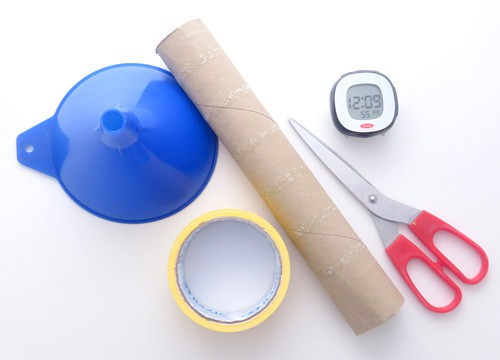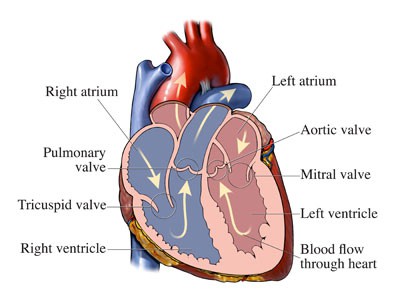Measuring Heart Rate with Your Own Stethoscope
Summary

Overview
In this fun, hands-on lesson, students explore their heartbeats and learn about blood circulation. They will make their own stethoscopes, use them to measure their heart rates and investigate how heart rate is affected by exercise.Learning Objectives
- Understand the function of the heart and blood.
- Relate heart rate to blood flow and pulse.
- Measure and interpret how heart rates are affected by exercising.
NGSS Alignment
This lesson helps students prepare for these Next Generation Science Standards Performance Expectations:- 4-LS1-1. Construct an argument that plants and animals have internal and external structures that function to support survival, growth, behavior, and reproduction.
|
Science & Engineering Practices
Engaging in Argument from Evidence. Construct and/or support an argument with evidence, data, and/or a model.
Analyzing and Interpreting Data. Represent data in tables and/or various graphical displays to reveal patterns that indicate relationships. |
Disciplinary Core Ideas
LS1.A: Structure and Function. Plants and animals have both internal and external structures that serve various functions in growth, survival, behavior, and reproduction.
|
Crosscutting Concepts
Cause and Effect. Cause and effect relationships are routinely identified, tested, and used to explain change.
Systems and System Models. A system is a group of related parts that make up a whole and can carry out functions its individual parts cannot. |
Materials
 Image Credit: Sabine De Brabandere, Science Buddies / Science Buddies
Image Credit: Sabine De Brabandere, Science Buddies / Science Buddies
For each group of two students:
- Plastic funnel
- A cardboard tube from a paper towel roll
- A strip of duct tape or other strong tape
- Scissors
- Stopwatch or clock that counts seconds
Background Information for Teachers
This section contains a quick review for teachers of the science and concepts covered in this lesson.A stethoscope (steth- ə-sk ōp), such as the one shown in Figure 1, is a medical instrument used to listen to sounds produced inside the body, especially the sounds produced by the heart and lungs or of blood flowing in blood vessels. The small disc placed on the body picks up small sounds and amplifies them. They are then guided to the listener's ear(s) by an air-filled tube.
 Image Credit: Wikimedia Commons user Sonarpulse. origenal:Huji / Public Domain
Image Credit: Wikimedia Commons user Sonarpulse. origenal:Huji / Public Domain
Figure 1. A stethoscope.
The heart, which is a muscle about the size of your fist, is part of the circulatory or cardiovascular system, your body's transportation system for nutrients and oxygen. Each time it contracts, it pushes blood to all parts of the body. Blood is a carrier. It transports oxygen from the air you breathe and nutrients from the food you eat. It also transports waste away and helps keep body temperature steady. An average adult has about 4.7 liters (one and a quarter gallons) of blood. An 80-pound child has about half as much blood.
You can hear a heartbeat using a stethoscope. What you hear as a heartbeat is the sound of the valves in the heart closing. These valves keep blood from flowing the wrong way, as shown in Figure 2. When you feel or listen to your pulse, you feel or hear the throbbing of blood flushing through the arteries. It is best felt in the wrists or neck. As it is the heart that pushes blood through the arteries, each heartbeat is accompanied by a pulse.
 Image Credit: www.imgarcade.com
Image Credit: www.imgarcade.comA human heart has two main chambers: a left and right atrium on top of the heart, and a left and right ventricle on the bottom of the heart. Other parts of the heart include the pulmonary valve, tricuspid valve, aortic valve, and mitral valve.
Figure 2. A picture of the heart with its two chambers and four valves (image from www.imgarcade.com)
A heart rate or pulse is usually expressed in terms of the number of beats per minute (BPM). To measure a heart rate or pulse, it is easier to count the number of beats or pulses for 15 seconds and multiply that value by four (to get the number of beats in one minute). You can calculate how many times your heart beats in a year by multiplying your BPM by 60 minutes per hour, 24 hours per day, and 365 days per year. A BPM of 70 beats per minute yields over 36 million beats a year!
In this science activity, students make their own stethoscopes using a cardboard tube, a funnel, and tape, and use these to measure other students' heart rates. They will measure pulses as well. By comparing the pulse to the heart rate, they will discover that the heart rate and the pulse are identical, an argument in support of the hypothesis that the heart beats to push blood through the body.
Students will also compare pulses at rest and immediately after exercise. They will discover that heart rates increase while exercising. This happens because the body needs more oxygen while exercising, and consequently, the heart beats faster to deliver more oxygen-rich blood, which increases the heart rate.



